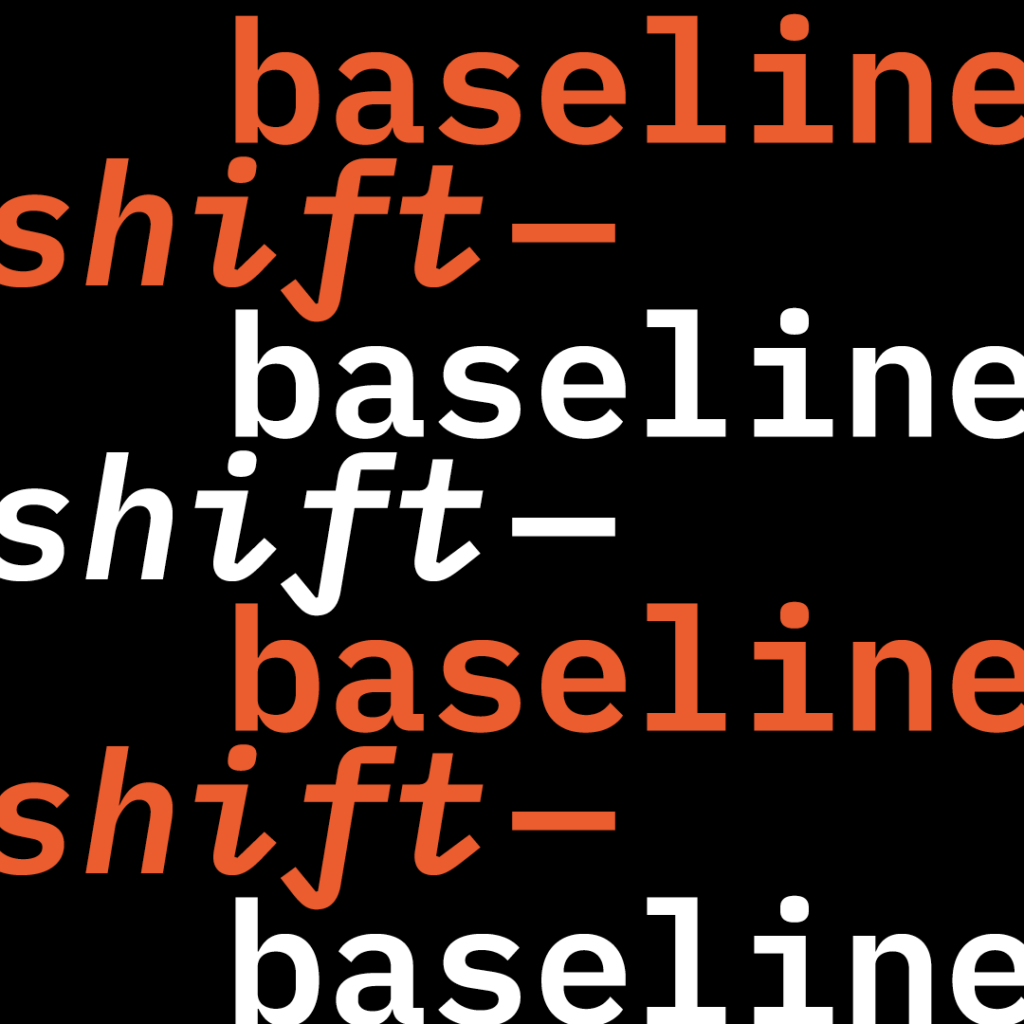Background
For the past two years, I have been part of the team that runs, promotes, and documents our Department’s series of design talks titled ‘Baseline shift’. Baseline shift sessions involve a variety of people including guest speakers, lecturers and past Graphic Communication graduates. They are targeted at us, design students, and aim to extend our outlook on the design world in addition to our degree programme. They often provide insight into working and progressing in the design industry. Baseline shift runs weekly throughout Autumn and Spring term.
Insights from previous years
In the 2018/19 academic year, Baseline shift talks were not always regarded by students as useful and enjoyable. Many talks were given by university speakers about somewhat mundane topics like academic writing. Whilst this is beneficial for the development of students, it was clear that these types of sessions were perhaps not the best fit for Baseline shift: they were not what students wanted or expected from it as an additional asset to their studies. Sessions from guest speakers with a career focus had better reception.
The posters we hung in the Department to promote Baseline shift were originally large-scale compositions of multiple squares of cards. This meant that posters consumed both significant amounts of time (in construction) and paper every week; we recognised a need for change. Our client, Part 1 tutor and lecturer James Lloyd, expressed a desire to sustain the uniqueness of the poster shape. I came up with the idea to print the design at an angle on paper, and hang it such that it was level, leaving an unusual and eye-catching shape on the wall, which worked as a window to the repetitious design.
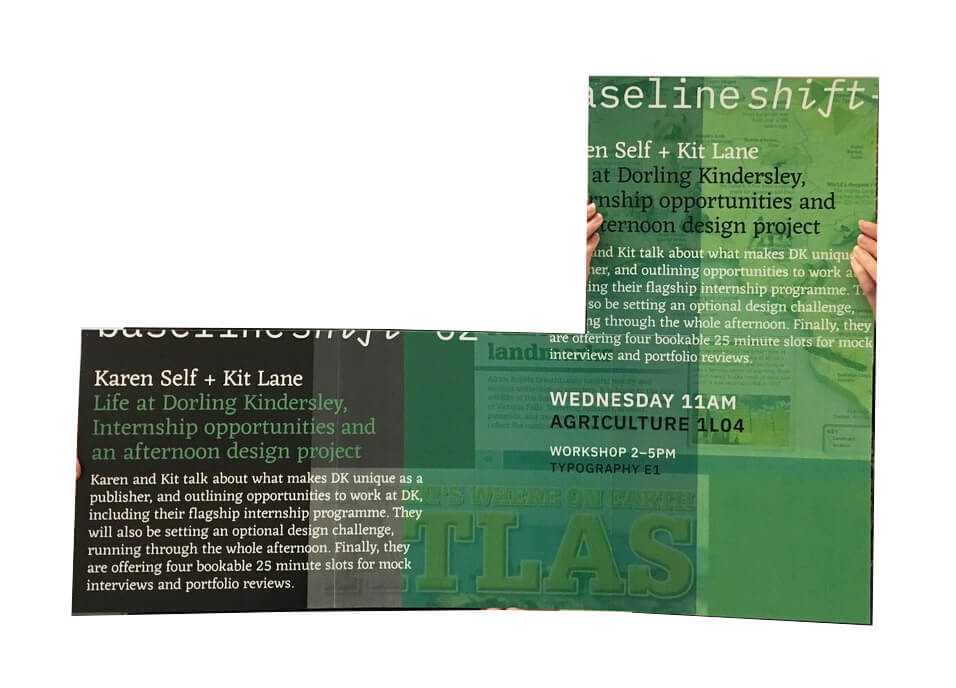

In the 2019/20 academic year, we worked together as a team to write a set of guidelines that determined the structure of a Baseline shift blog post – the write-up of each session. Some of the most important points were to do with writing style. We defined this together as:
- Energetic
- Excited
- Supportive of the Department
- Not just narrative and descriptive
This strategy of consolidating everyone’s thoughts and creating guidance is something that has greatly aided us this year.
This year
This academic year, I took on the position of team leader alongside a team of three other students, all new to the job. The brief was outlined as: ‘run, promote, blog and improve the Baseline shift series of student talks in the Department’. Our primary aim was to make Baseline shift more student-led, increasing our involvement in organising sessions. We were asked to focus on the following points:
- Booking more of the kinds of speakers that students like
- Improving blog posts and social interactions around each event
- Consistent gathering of session feedback
- Student-led evaluation of sessions
- Student-led proposals for new speakers
In previous years, Baseline shift was predominantly planned by our client, James Lloyd, yet he was keen to change this. This was a key part of my focus when taking on the job. We began preparation during the summer break prior to Autumn term. Our primary challenge was to find designers or professionals willing to speak to us about design, their careers and to inspire us in our studies – something we had not done before. Our client had pre-planned some talks, but we had dates to fill.
Organising the team and sessions
As a team of four, we worked with more organisation than previously. We gave ourselves roles for each term such that we could get used to our commitments. Alongside my role as team leader, and the role of speaker contact, two of us worked to promote the sessions, whilst two of us worked to run and document them. Splitting up the team like this worked well, as within these subgroups we could adjust our tasks when wanted or needed, yet we each had a clear focus and could therefore easily make improvements to our workflow.
This year, we worked significantly more to run and organise Baseline shift events, as well as promote and write about them. This upped our workload, yet I believe it increased the value of the sessions and our ability to ensure their quality. Good organisation was key, and as such we ensured that we all had quick access to our assets, guidelines and the schedule at all times. I spent significant time, due to my experience on Baseline shift, extending the guidelines we had previously created for blog posts, and in addition, writing new guidance for the setup of our design files and more comprehensively summing up our weekly roles. This was to ensure that we could work efficiently and with clarity.
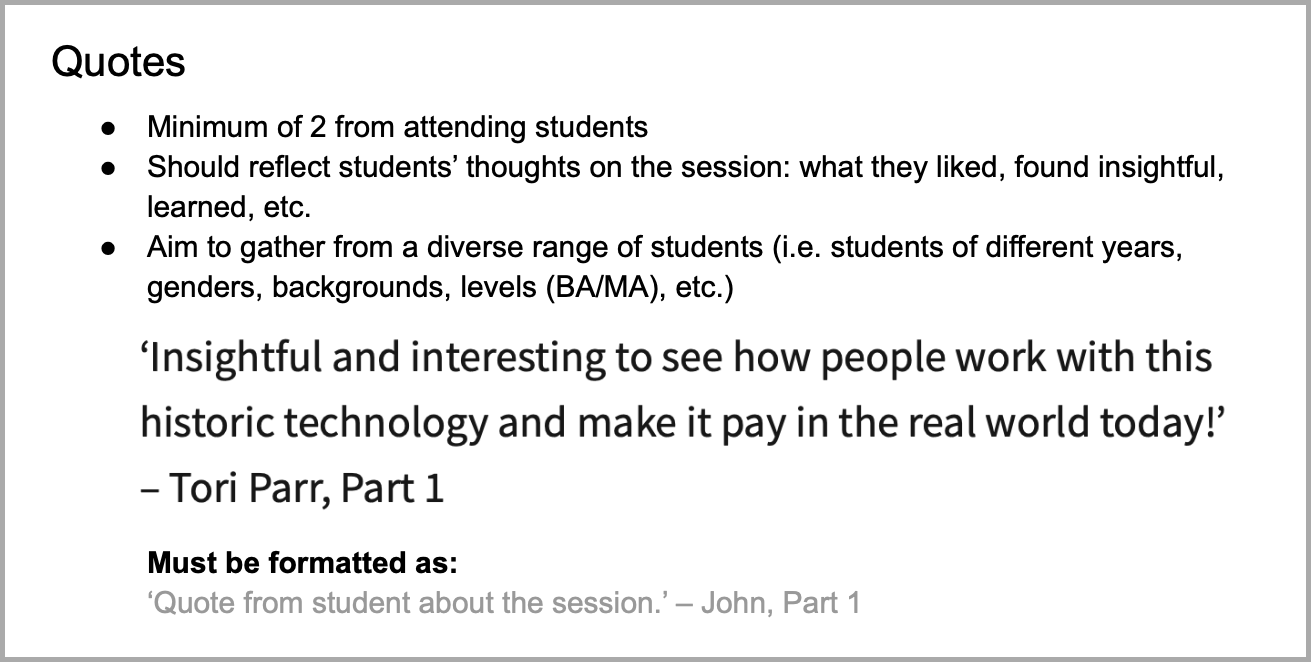
We devised a message to email to potential speakers as a team. Each of us went and searched for design professionals who we thought would be willing to talk to us and would have something interesting to say. Collectively, we connected with 10 speakers – these include alumni, the designer and print-maker Carl Middleton, and the Bulgarian branding and motion design studio, FourPlus. The latter two speakers’ sessions were particularly well received by students.
‘The diversity of work showcased was unbelievably amazing and so inspiring. It was so nice to learn about a designer’s career and how he stumbled upon opportunities to work on interesting projects.’ – Part 2 student
‘Branding design is really something to be admired because you really have to have a certain *flair* – and Ivaylo definitely has that! The decisions he talked about in his work really show an attention to detail and it is so fascinating to hear. Really awesome work, especially loved the pizza one.’ – Part 3 student
Successfully booking speakers and having their sessions be a success was greatly satisfying. Our feedback highlights that students found Baseline shift both enjoyable and valuable. This is something which I think we furthered this year, primarily by selecting a variety of speakers with interesting and insightful design careers.
Hosting sessions online
This year, due to the ongoing COVID-19 pandemic, it was necessary for Baseline shift to move online. This posed the immediate challenge of figuring out how to run an online session appropriately, in order to allow for smooth presentation and audience interaction. Our client decided that we should host sessions on Blackboard Collaborate, which allowed the sharing of screens, cameras, graphics and live chat.
Running sessions – introducing speakers and hosting Q&As – was a personal challenge, given that I am not a natural speaker. I valued the opportunity to do this in person last year, as it increased my confidence in front of a live audience. Online sessions made it easier for us all to speak, and so this further helped me to develop my skills at running a session. We learned how best to do this across the course of the whole year, and this helped us to form a set of guidance for ourselves, and subsequently define what a Baseline shift session is like. Students’ expectations of a sessions are hopefully more unified as a result of this.
In reflection, the move to online sessions have enabled Baseline shift to be more easily accessible to all, and also enabled us to invite speakers from other countries – something that in previous years was more difficult.
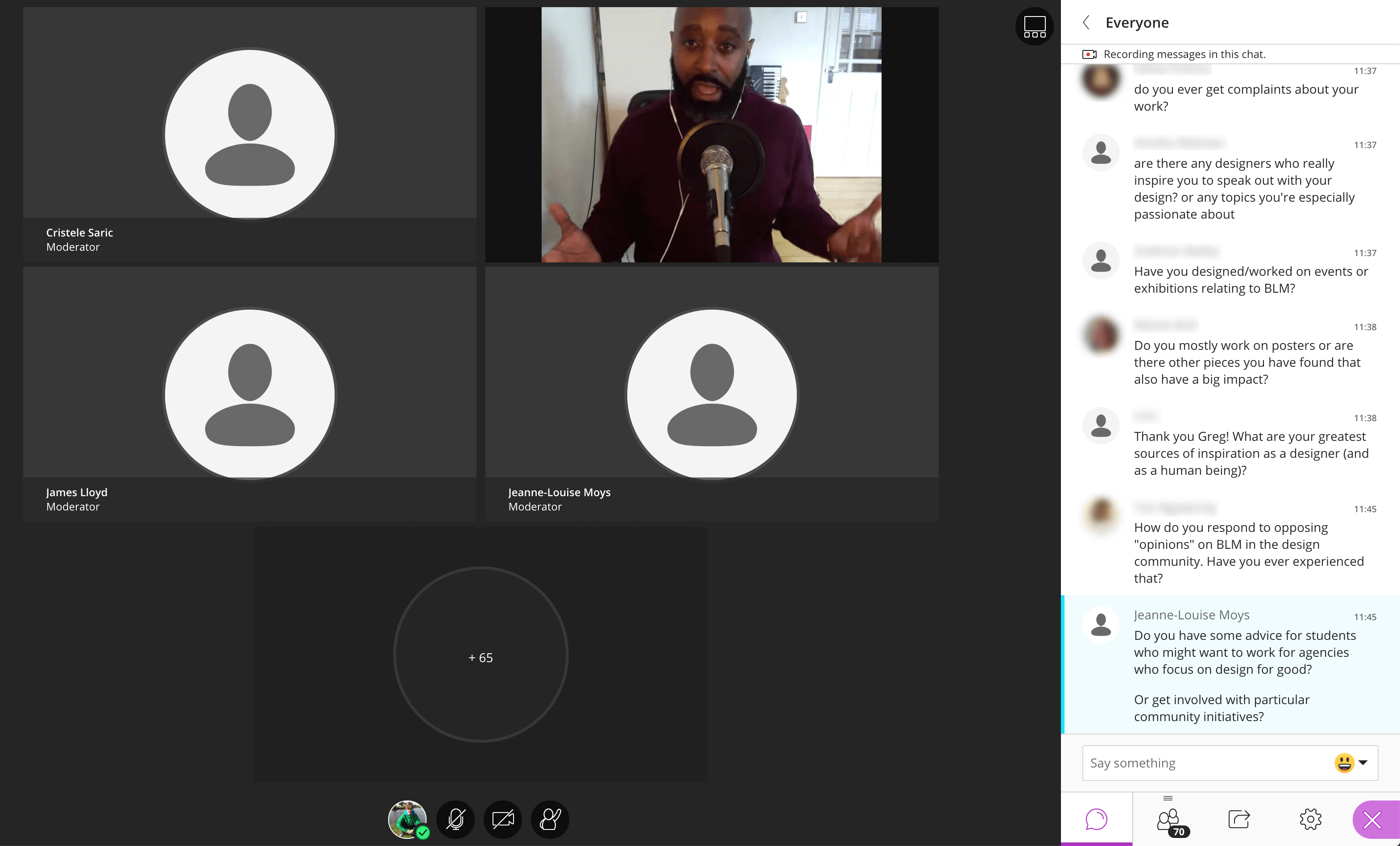
Graphics and promotion
Whilst in my second year on the Baseline shift team, I saw the opportunity to reduce our colour pallet to just five core colours that corresponded to the structure of university terms, making it easier to apply. These colours could repeat twice a term, either side of the break, and enable Baseline shift to build better brand recognition, and also to mimic its termly schedule in colour. Over time, we refined these colours as a team to include a purple; I suggested that they should be bright and vibrant, as I viewed this appropriate to our audience, and relevant to how we wanted Baseline shift to appear: exciting and valuable.
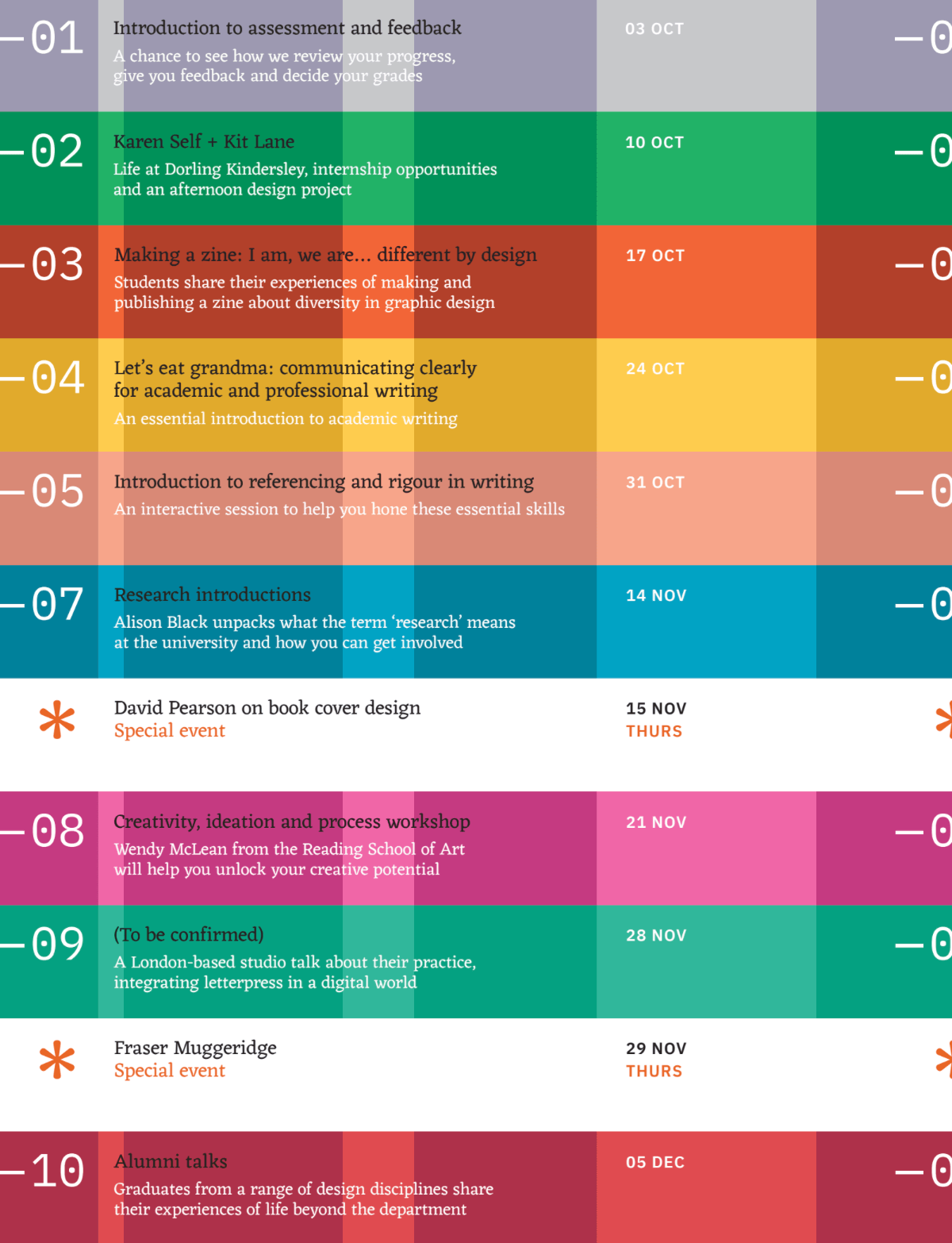
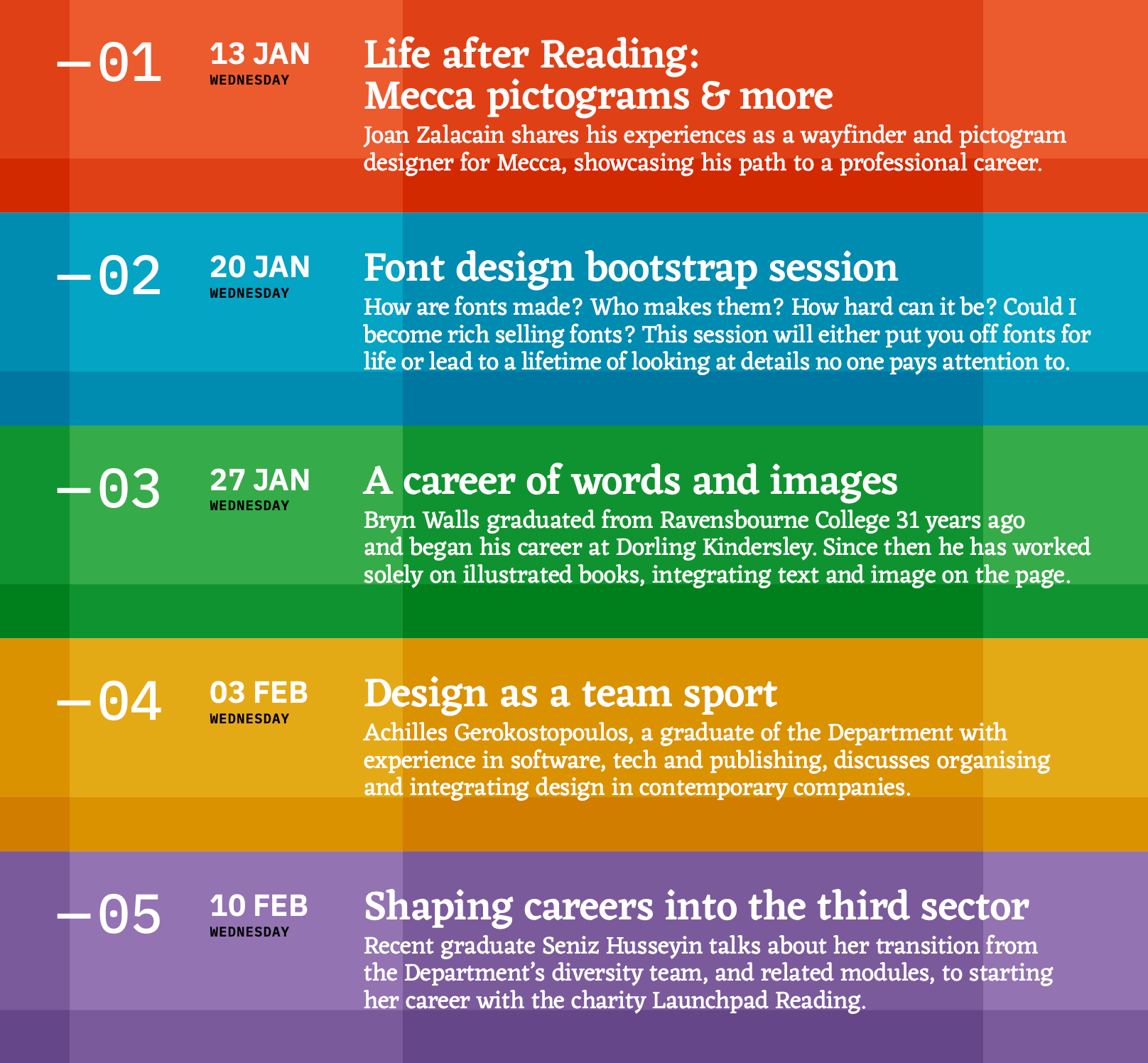
This year, we made the decision to move forward with the existing Baseline shift brand, and not to rebrand, due to its established recognition. However, digital graphics were particularly important given the current climate. All graphic assets were refined and unified, such that they made a better use of the mediums in which they were presented, and so that Baseline shift appeared somewhat fresh. We created new graphics for use in sessions, and to promote sessions on the Department’s big screen.

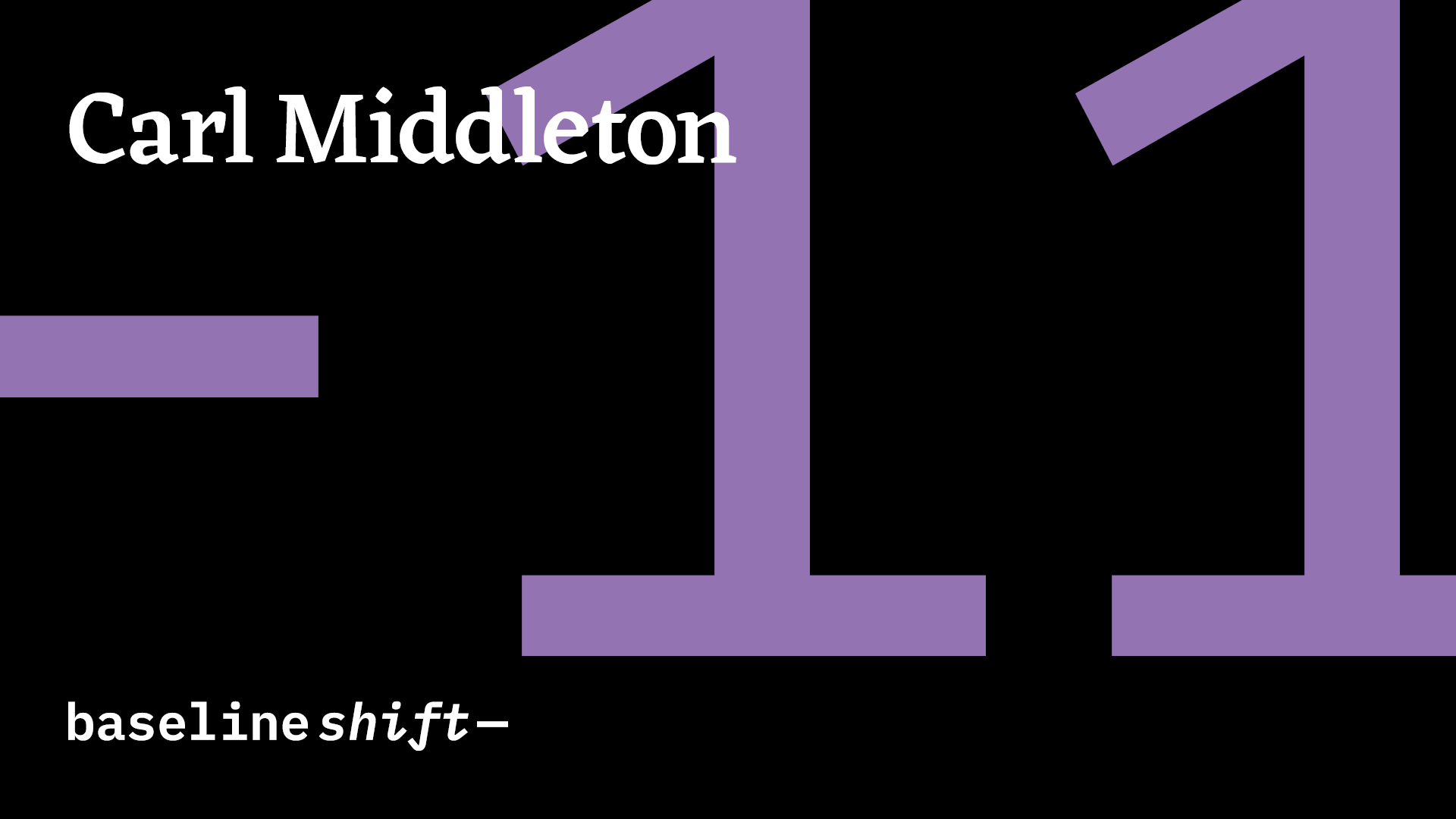
Given the low turnout of some sessions in previous years, particularly of Part 2s and 3s, I wanted to cast more energy into the Baseline shift brand and promotion. I considered Instagram stories to be a good tactic for the promotion of sessions, given that students on our course tend to follow our Department’s Instagram. I proposed an extended use of stories to up the energy behind promotion, emphasising our name, the time, and location, in addition to the primary graphic which is harmonious with our other designs such as our poster and Facebook graphic. This was further to the previous approach which was to simply repost the poster graphic alone on both Facebook and Instagram.

As a result of creating standalone graphics for each application this year, we needed to optimise our InDesign files such that we did not have to manually edit each graphic – particularly given the bleeding and repetitive nature of the Baseline shift identity. I set up our files with cross references, meaning that each week we could simply change all the information on the master page, and press update. This certainly made our workflow more efficient and saved us time.
For Spring term of this year, our client suggested that we should try to work with images. We decided to use one image to promote each session, and this led us to a more dynamic approach to our Facebook promotion. I believe that the imagery was a positive addition, as it allows for students to get a better sense of the speaker or the design work which will be discussed in the session.
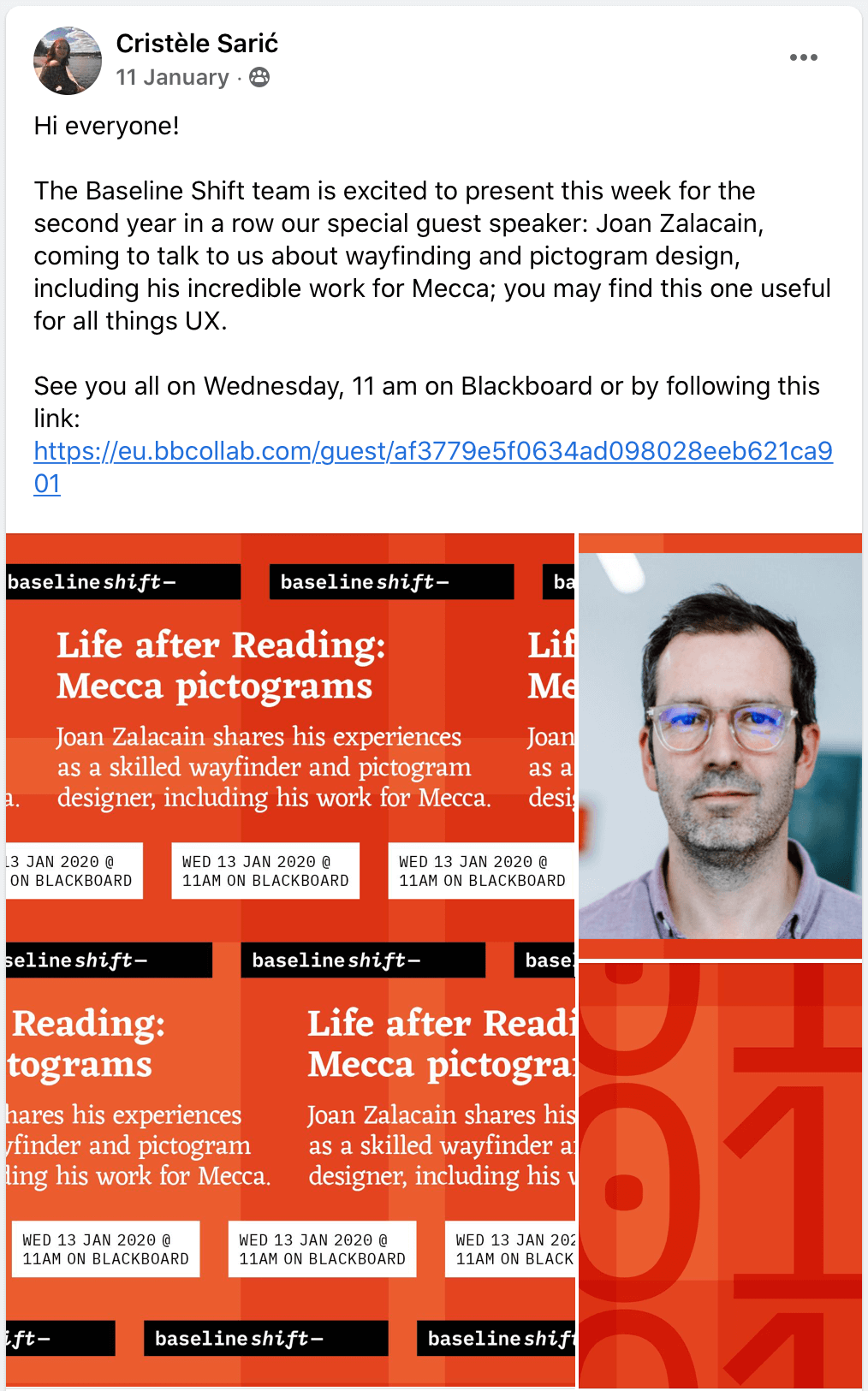
Another crucial part of promotion is in the messaging that accompanies the graphics. I emphasised the need for us to stress the benefits of why students should attend, whilst keeping explanations succinct and quick to read. I think this approach is successful as it makes our messaging more personable whilst showing direct relevance to our audience.
Writing blog posts
Documenting sessions, in the form of blog posts – like this one – has always been a part of running Baseline shift. This year we worked hard to keep on top of this and to write a blog for every session, even those that are not perhaps the most exciting such as a Feedback jam. I was surprised as to how well this worked, and how much we could always find to write about, no matter the topic. This year, we completed 20 blog posts: one for every session. Blog writing has become evidently beneficial to me, as it serves to sum up our key learnings from the talks and to subsequently educate others. For this reason, I suggested to my team that we should strive to phrase things with ‘you’ in posts, and provide direct suggestions for readers to take.
In previous years, blog posts were less organised and more infrequent, and did not retain a set style in writing or design. I worked hard to extend the guidelines we had devised as a group last year, to define what a Baseline shift blog post most fundamentally is and how it should be structured. This not only made the process easier for us in terms of writing, but should also help readers to be more at ease with our content.
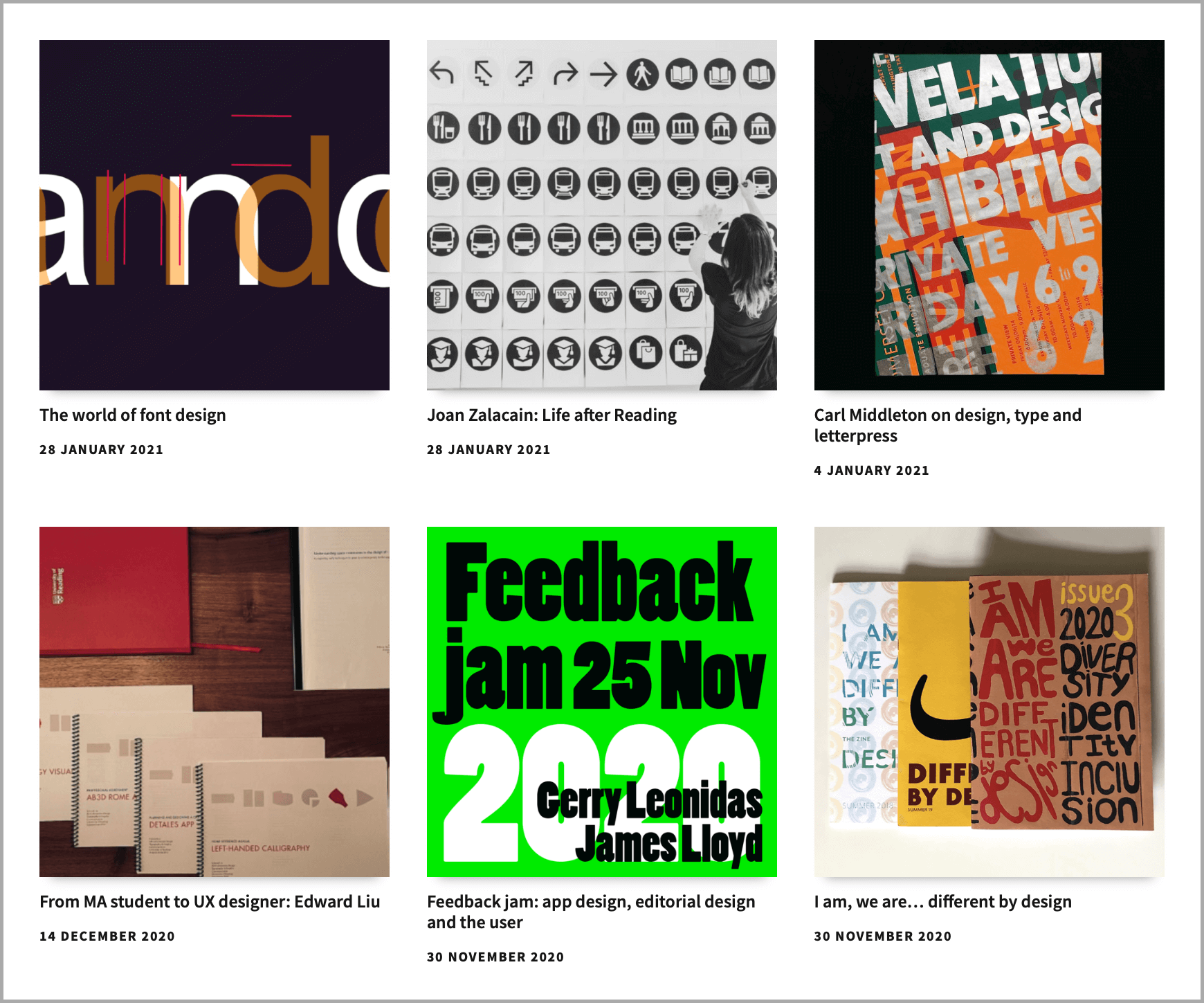
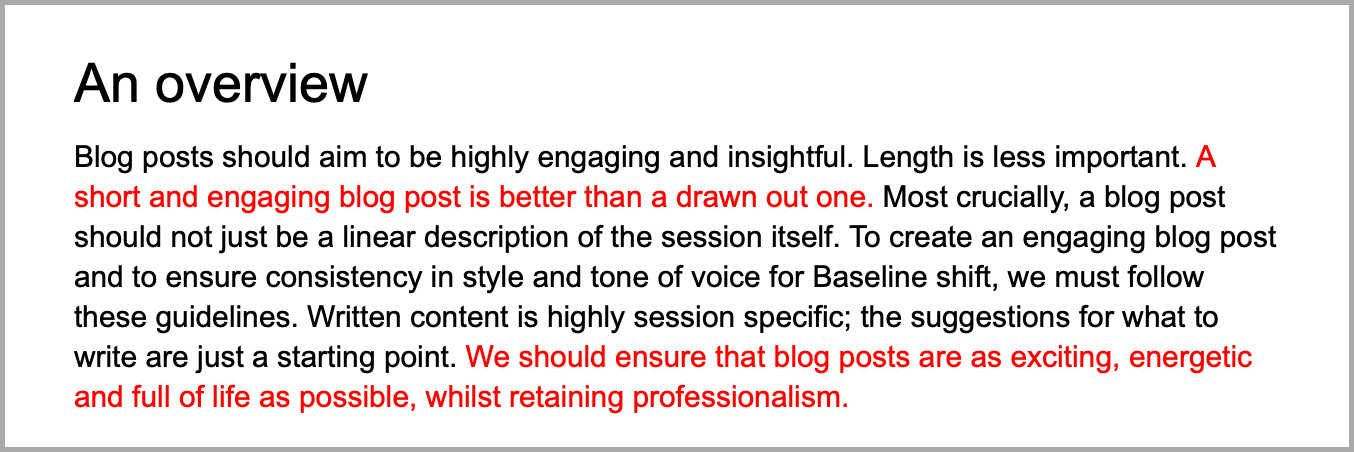
Reflection
In summary, working on Baseline shift has been a particularly valuable experience for both me and my team members. The variety of tasks involved, including promotion, speaking, writing, planning and designing, has allowed me to largely broaden my skills. Baseline shift has strengthened my ability to manage and work within a team. Moving forwards, I will certainly feel more confident when taking on leadership roles.
If I were to alter one thing, I may impose fewer limits on the graphics such that we could have more freedom to explore layout and imagery each week. Finding the balance between productivity and creativity is something that I feel could be worked on with our graphics templates. However, Baseline shift sessions themselves are equally or arguably more important to students than the appearance of promotional graphics. Overall, I believe that we have succeeded in improving Baseline shift sessions, and in increasing the student leadership of Baseline shift.
‘Huge thanks once again to all our contributors, but especially to our student team of Alex, Amina, Mitko and Cristele who are absolutely bossing these now, with only limited input from me.’ – James Lloyd, our client
Baseline shift will return in October 2021 for the new academic year.

